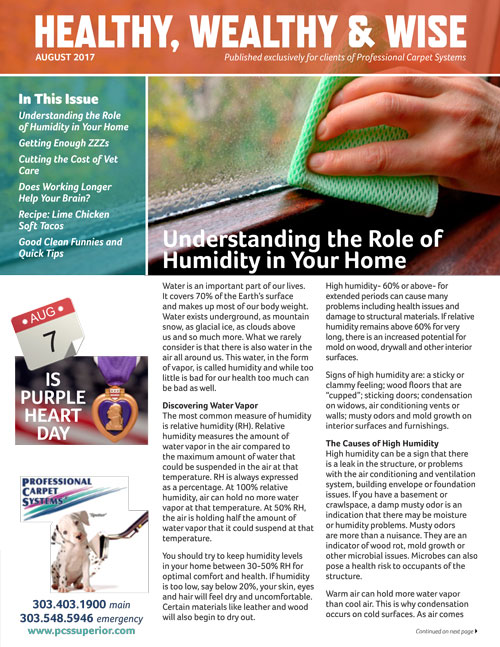Here’s our client newsletter for August 2017.
Click Here to See Our Newsletter
Understanding the Role of Humidity in Your Home
Water is an important part of our lives. It covers 70% of the Earth’s surface and makes up most of our body weight. Water exists underground, as mountain snow, as glacial ice, as clouds above us and so much more. What we rarely consider is that there is also water in the air all around us. This water, in the form of vapor, is called humidity and while too little is bad for our health too much can be bad as well.
Discovering Water Vapor The most common measure of humidity is relative humidity (RH). Relative humidity measures the amount of water vapor in the air compared to the maximum amount of water that could be suspended in the air at that temperature. RH is always expressed as a percentage. At 100% relative humidity, air can hold no more water vapor at that temperature. At 50% RH, the air is holding half the amount of water vapor that it could suspend at that temperature. You should try to keep humidity levels in your home between 30-50% RH for optimal comfort and health. If humidity is too low, say below 20%, your skin, eyes and hair will feel dry and uncomfortable. Certain materials like leather and wood will also begin to dry out.
You should try to keep humidity levels in your home between 30-50% RH for optimal comfort and health. If humidity is too low, say below 20%, your skin, eyes and hair will feel dry and uncomfortable. Certain materials like leather and wood will also begin to dry out.
High humidity- 60% or above- for extended periods can cause many problems including health issues and damage to structural materials. If relative humidity remains above 60% for very long, there is an increased potential for mold on wood, drywall and other interior surfaces.
Signs of high humidity are: a sticky or clammy feeling; wood floors that are “cupped”; sticking doors; condensation on widows, air conditioning vents or walls; musty odors and mold growth on interior surfaces and furnishings.
The Causes of High Humidity High humidity can be a sign that there is a leak in the structure, or problems with the air conditioning and ventilation system, building envelope or foundation issues. If you have a basement or crawlspace, a damp musty odor is an indication that there may be moisture or humidity problems. Musty odors are more than a nuisance. They are an indicator of wood rot, mold growth or other microbial issues. Microbes can also pose a health risk to occupants of the structure.
Warm air can hold more water vapor than cool air. This is why condensation occurs on cold surfaces. As air comes into contact with the cold surface, the air gets cooler, and the RH increases. If the surface is cold enough, RH reaches 100%. Since the air can no longer hold all of the water vapor condensation forms on the surface of the cooler material. We call this the dewpoint temperature.
If you have a basement, sunroom or unfinished area that is sometimes cooler than the rest of your house, temperature variations can lead to excessive relative humidity, condensation and all of the associated problems. In these areas it may be necessary to use a dehumidifier to control moisture in the air. Remember, if the air is damp so is the structure. Keeping humidity under control is one step toward making your home a healthier place to live.
High humidity is a sign that something is wrong with a structure. If you suspect you have any kind of water damage from a leak, condensation, poor construction or foundation issues, call Professional Carpet Systems today. We can help identify the problem, prevent further damage and assist you in finding the right solution.

